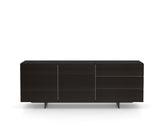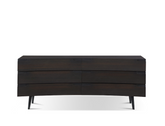Easy Steps to Clean and Protect Leather Sofas

Why do some leather sofas retain their luxurious allure over the years, while others begin to look worn and tired after just a short period? The secret is in proper care and maintenance. Just like maintaining a luxury vehicle requires regular attention, your leather sofa, too, thrives on consistent care. Over the years, it will endure countless family movie nights, occasional spills, and hours of lounging. Ignoring its maintenance would only accelerate its decline.
A leather sofa isn’t just another piece of furniture; it’s a statement of elegance, a reflection of your home’s style. But without proper cleaning and maintenance, even the most exquisite leather sofa will lose its charm over time. By adopting regular leather sofa cleaning routines, you ensure the leather remains soft, lustrous, and resistant to the inevitable wear and tear that comes with everyday use.
Why DIY Leather Sofa Cleaning is Better than Professional Services
Many homeowners feel uncertain about entrusting their valuable items to someone else. Think of it like handing over a prized watch for repair; you’d want to be sure the person handling it knows what they’re doing. The same applies to your leather sofa. Opting for DIY cleaning means you're in full control of the process. You'll know exactly what products are being used and can be sure that each section is being handled with care. Plus, the satisfaction of cleaning your sofa to a professional standard and the money saved makes DIY a fantastic choice.
While professional cleaning can be effective, it may not always be necessary. Minor spills, regular dusting, and conditioning are tasks you can easily handle on your own, saving time and money in the long run.
Essential Materials for DIY Leather Sofa Cleaning
Before diving into cleaning, gather the necessary tools and products to ensure the job is done right. Here’s a list of what you’ll need:
Basic Cleaning Products:
- Soft cloth
- Mild dish soap
- Water
- Leather conditioner
Additional Items for Deep Cleaning:
- Vacuum with brush attachment
- Leather stain remover
- Baby wipes
Step-by-Step Guide to Cleaning Your Leather Sofa
1. Pre-cleaning Assessment
Before applying any new cleaning product to your leather sofa, always perform a test on an inconspicuous section. This ensures that the product won’t cause discoloration or damage. Once you're confident the product is safe, proceed with cleaning.
2. Basic Cleaning Procedure
Dust the surface of the sofa using a soft cloth to remove loose particles. Mix mild dish soap with water to create a gentle cleaning solution. Dampen a cloth with this solution and carefully wipe down the entire sofa, paying attention to any visible stains or dirty spots. Once cleaned, dry the sofa thoroughly using a clean, soft cloth. Finally, apply a quality leather conditioner to maintain the leather's suppleness and shine.
3. Tackling Stubborn Stains
Accidents happen, and stains are sometimes unavoidable. Whether it’s red wine, coffee, or ink, these can be daunting. For stubborn stains, use a specialised leather stain remover or even baby wipes. Just remember to test these products on a hidden spot first to ensure they don't cause any damage.
Leather Sofa Maintenance and Care Tips
Protecting Your Leather Sofa from External Elements
Leather is sensitive to environmental factors such as sunlight and heat. Just as prolonged sun exposure can damage our skin, too much sunlight can cause leather to fade and crack. Positioning your leather sofa away from windows and heat sources like radiators will prevent this kind of damage.
By ensuring your leather sofa isn’t exposed to extreme heat or direct sunlight, you can significantly extend its lifespan and keep it looking new for much longer. It’s a simple step, but it makes a significant difference.
Establish Regular Maintenance Routines
Caring for your leather sofa is not just about cleaning up spills as they occur. Routine maintenance is essential to preserve its beauty. Dust it regularly with a soft cloth to prevent dirt buildup. Use a vacuum cleaner with a brush attachment to clean the sofa’s crevices, where dust and debris can accumulate.
Conditioning the leather with a high-quality leather conditioner once or twice a year is crucial to maintaining its softness and shine. Regular conditioning not only makes the sofa look good but also protects it from drying out and cracking.
Managing Minor Wear and Tear
Over time, all leather sofas will develop signs of wear, such as minor scratches or scuffs. Instead of viewing these as imperfections, think of them as signs of character. Small imperfections can add depth to the sofa’s appearance, making it uniquely yours.
For minor blemishes, a simple leather repair kit or a dab of leather conditioner can work wonders. However, for larger issues, it's best to consult professionals who can restore your leather sofa to its former glory.
Understanding Different Leather Types and Their Care Requirements
Different types of leather require different cleaning methods. Here’s a quick guide to help you identify your sofa’s leather type and the best way to care for it:
- Aniline Leather: Soft and luxurious, aniline leather is natural-looking and retains the hide's unique surface. However, it is susceptible to staining and fading, so it needs extra care.
- Semi-Aniline Leather: This leather has a slight protective coating, which makes it more resistant to stains and fading while retaining the softness of aniline leather.
- Pigmented Leather: The most durable of the three, pigmented leather is resistant to scratches, scuffs, and stains, making it ideal for homes with children or pets.
Tailoring your cleaning techniques to the type of leather will ensure the longevity and beauty of your sofa.
DIY Natural Cleaners for Leather Sofas
If you prefer natural cleaning solutions, there are several household items that can safely clean leather:
- Vinegar and Water: Mix equal parts white vinegar and water for a gentle leather cleaner.
- Lemon Juice and Cream of Tartar: For stubborn stains, mix lemon juice with cream of tartar to create a paste. Apply it to the stain and let it sit before wiping clean. As always, test on a hidden spot first.
Proper Storage for Leather Cushions and Pillows
If you need to store leather cushions or pillows, avoid using plastic covers, as leather needs to breathe. Instead, wrap them in a cotton sheet and store them in a cool, dry place to prevent dust accumulation and protect them from damage.
FAQs About Leather Sofa Cleaning
Q: Is it safe to use baby wipes on my leather sofa?
A: Yes, baby wipes can be used for small stains and spot cleaning. However, always test on a hidden area first to ensure they won't damage the leather.
Q: How often should I condition my leather sofa?
A: It’s recommended to condition your leather sofa every 6 to 12 months. However, if your sofa is frequently exposed to sunlight or heat, more frequent conditioning may be necessary.
Conclusion
Maintaining a leather sofa is about more than just cleaning up after the occasional spill. With regular cleaning, protection from environmental elements, and routine conditioning, your leather sofa can remain the centrepiece of your living room for many years to come. By following these effective DIY leather sofa cleaning tips, you’ll not only preserve the beauty and comfort of your sofa but also protect the investment you’ve made in your home’s style and ambience. With a little effort and the right care, your leather sofa will continue to shine, providing comfort and luxury for years to come.







